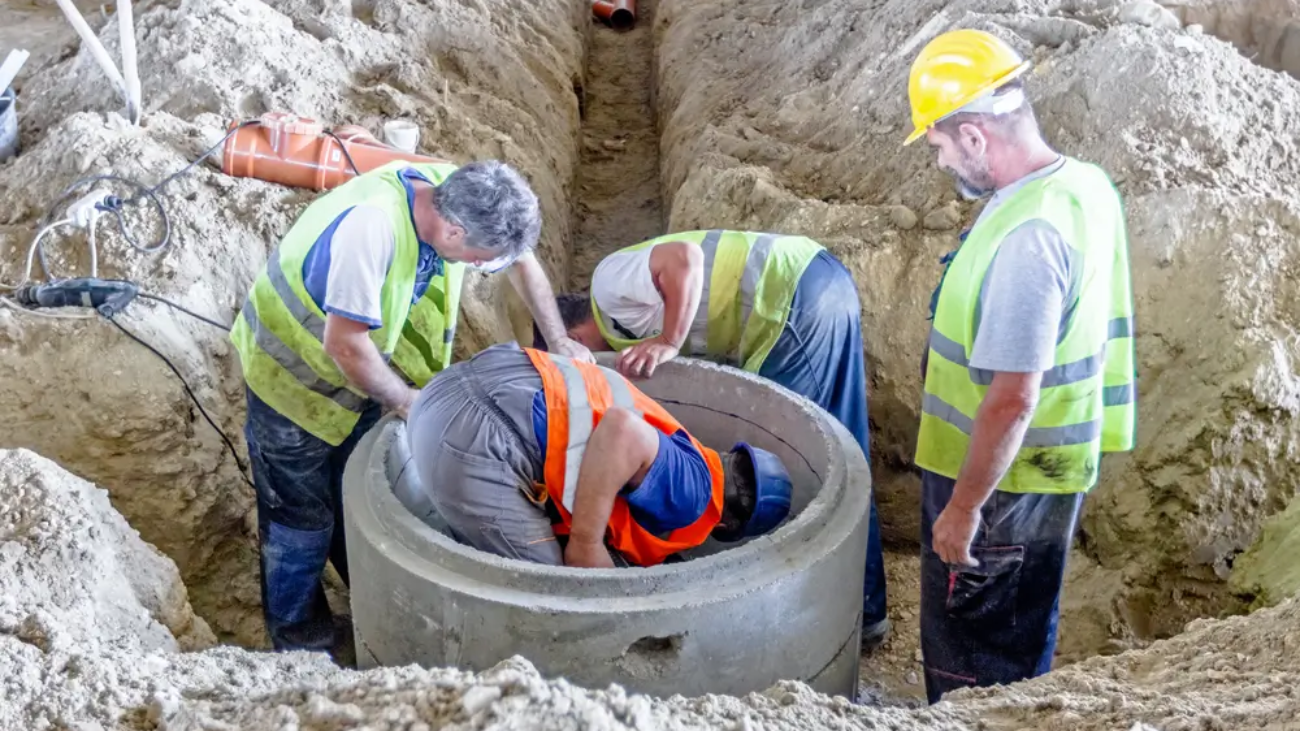Construction sites often have tight, enclosed areas that seem normal at first glance, but some of these spaces can be extremely dangerous. These are called confined spaces, and workers need to know how to spot them before stepping inside.
OSHA (Occupational Safety and Health Administration) has specific rules for confined spaces. Knowing how to identify them quickly can help prevent injuries or even save lives. This guide explains what makes a space “confined” and gives you simple steps to identify these spots on any construction site.
What Is a Confined Space?
According to OSHA, a confined space is an area that:
- Is large enough for a person to enter and work,
- Has limited or restricted means of entry or exit, and
- Is not designed for continuous occupancy.
All three points must apply for a space to be called a “confined space.”
Common Examples on Construction Sites
You can find confined spaces in many places across a worksite. Some of the most common include:
- Utility vaults
- Storm drains
- Crawl spaces
- Manholes
- Silos
- Tanks
- Pits and trenches (depending on depth and entry/exit limits)
- Boilers
- Air ducts
Not all of these are automatically dangerous, but many can become hazardous without warning.
Step-by-Step: How to Spot a Confined Space
Step 1: Look at the Size and Access
Ask yourself:
- Can a person fully enter this space?
- Is the entrance small, narrow, or difficult to pass through?
- Is there only one way in or out?
If the area is large enough to fit someone but has tight entry or exit points (like a ladder or a small hatch), it might be a confined space.
Step 2: Ask if People Work There Regularly
Confined spaces are not meant for regular human activity. If workers only go inside to make repairs, do inspections, or clean something, and don’t stay inside long, it could be a confined space.
If a space has lights, desks, and ventilation, it’s probably not confined. If it’s dark, stuffy, and only accessed occasionally, it likely qualifies.
Step 3: Check for Limited Air or Movement
Ask:
- Is airflow limited or poor?
- Is it hard to move around inside?
- Does the space feel closed in?
Even if a space looks harmless, it may trap heat, fumes, or gases. A lack of fresh air is a key sign you’re dealing with a confined space, and possibly a hazardous one.
Permit vs. Non-Permit Confined Spaces
OSHA separates confined spaces into two types:
Non-Permit Confined Spaces
These are confined spaces without serious hazards. They still have entry restrictions but don’t have dangerous air, moving parts, or the risk of engulfment.
Example: An empty, clean crawl space under a building.
Permit-Required Confined Spaces
These are confined spaces that do have one or more hazards, such as:
- Toxic gases or lack of oxygen
- Risk of engulfment (sand, water, chemicals)
- Electrical hazards
- Sloped floors that could cause falls or entrapment
- Machinery that could start suddenly
If any of these apply, you must use a written permit system before anyone goes inside.
Example: A manhole with limited oxygen or active electrical cables.
Quick Signs a Space May Be Permit-Required
If you spot these, stop and assess before entry:
- Warning signs on the entry door
- Pipes going into or out of the space
- Strong smells or poor air circulation
- Unusual noises (e.g., gas hissing, water flowing)
- Water or grain buildup near the floor
- No clear exit path if something goes wrong
Always treat a space as dangerous until proven safe.
Questions to Ask Before Entering Any Space
- Is the space fully or partly enclosed?
- Is it hard to get in or out quickly?
- Is it designed for people to stay inside for long periods?
- Could something harmful be in the air?
- Could anything inside trap, crush, or hurt someone?
If you answer “yes” to the first three questions, it may be a confined space. If you also answer “yes” to the last two, it might be a permit-required confined space.
Who Should Identify Confined Spaces?
Supervisors, site managers, and safety officers are responsible for identifying confined spaces. However, every worker should be trained to recognize them.
Why? Because even experienced workers have been hurt or killed after entering unsafe spaces without realizing the risk.
Tools That Help with Identification
- Site maps and blueprints: Can highlight tight or enclosed areas
- Job hazard analyses (JHA): Often include confined space checks
- Confined space inventory sheets: List all known areas onsite
- Gas detectors: Alert you to poor air or toxic gases
- Training sessions: Help workers spot dangers early
Real-Life Risks
Construction workers have died in manholes filled with gas, tanks with no oxygen, and silos that collapsed. Many of these accidents could have been avoided with proper identification and controls.
What to Do If You Find a Confined Space
- Don’t enter right away
- Report it to your supervisor or safety officer
- Mark the area with signs or tape if possible
- Wait for trained staff to assess the space
- Follow the permit process if required
If the space needs special equipment or entry plans, it should only be accessed by trained, authorized personnel.
Final Tips for Staying Safe
- Always think before you enter a space that seems tight or enclosed
- Don’t rely on just appearance, some hazards are invisible
- Get trained on confined space awareness, even if you don’t enter them often
- Know where the permit-required confined spaces are on your site
- Watch out for co-workers, never let someone enter alone or unprotected
In Summary
Identifying a confined space is the first, and most important, step to keeping workers safe. Don’t wait until something goes wrong. Use your eyes, ask questions, and report spaces that match the confined space definition.
Quick action and awareness save lives.
Let me know if you’d like this article turned into a printable checklist or site audit tool!





